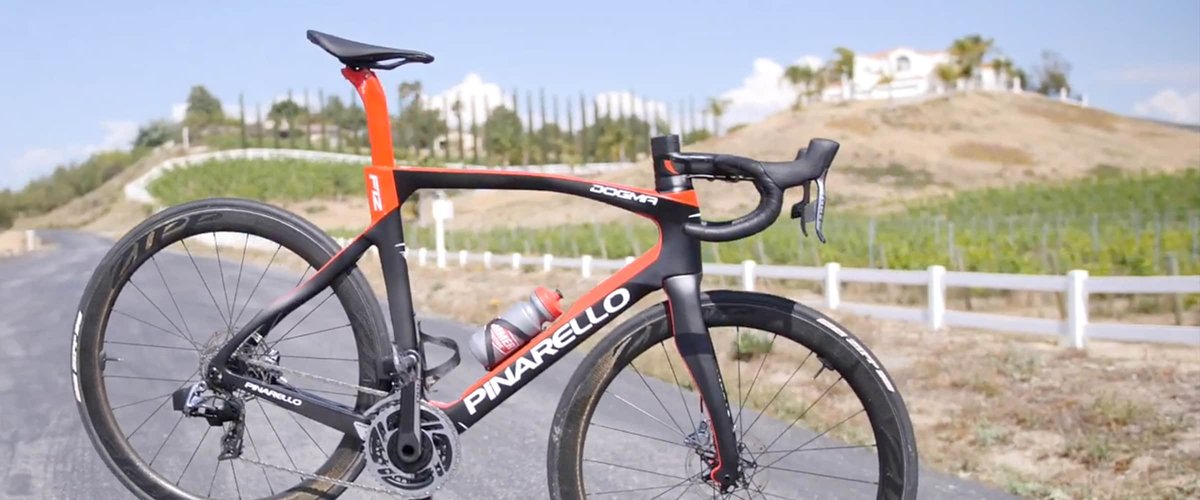
Video Review: Pinarello Dogma F12 vs. F10
There is perhaps no family of race bikes more universally admired than Pinarello’s Dogma line. Built as Grand Tour dominators, Dogmas have been a fixture atop podiums for just shy of a decade. With the release of the new Dogma F12, we enlisted Andy Clark to put the new bike to the test against its predecessor, the dominant Dogma F10, to see where the new bike manages to improve on what we had assumed was perfection.
Have I ever told you that my first REAL race bike was a Pinarello Prince? I’m not talking about the carbon one they’re selling right now, I’m talking about the aluminum one with carbon seatstays from around 1999 or 2000 – you know, the one Riis “won” the 96 tour on? It wasn’t Telekom pink, it was “cosmic blue” and I recall it being one most well-refined bikes I’ve ever owned. It was also a gateway drug.
Since then I’ve had 4 Pinarellos come in and out of my life…well, five actually. A really cool Lungavita single speed that I gave to a buddy who moved to Philly, A Dogma 65.1 Think2, which for two years was the daily driver, then the F8 came into my life for a few years, and I had a torrid 4-week love affair with a Dogma F10. And now this one, the F12. And, I’ve been asked to tell you how the 12 compares to the 10. But I can’t quite do that just yet. I’ll get to it, but first a little exposition.
If I were to pick a common thread or recurring theme among the Dogmas, it would – hands down – be telePATHIC handling. The 65.1, to this day, still conjures up fond memories of confidently carving my way through corners at speeds only single guys without kids should hold. I can say the same of the F8 and F10, but the F-series always felt a little…more racy?…sharper, maybe? More pointed, and purpose-driven? Whatever term I use – both were worlds lighter and went uphill at a much more lively pace than the 65.1
I think the word I’m looking for is aggressive. That’s the biggest switch that was flipped with the F series. It actually reminded me of a story a friend told me about the time he met Fausto Pinarello. This was 11 or 12 years ago at the Gran Fondo Pinarello, and my buddy – a respected frame builder in his own right – struck up a conversation with the man himself. Before long, the topic turned to the emerging trend to make bikes with ‘endurance’ or ‘comfort’ geometry. He asked him, “Fausto. I really wish the Dogma fit better. Why are your head tubes so short?”
Without missing a beat, in perfect, unbroken English he said: “Because we make racing bicycles.” And that’s what the F12 is: a perfect, unbroken, unfiltered race bike.
It’s almost unfair to compare it to the F10 because, from what I can tell, it’s a completely new bike. Yeah…I know it looks like all they did was put some clever bending in the tubes but it goes way beyond that. You see, in the short time since the F10 was created, a LOT has happened to road bikes – namely, disc brakes and internal cable routing have become standard – not optional.
The F12 is the very first Pinarello with 100% Total Internal Cable Routing – they call it TICR. That means there are ZERO cables exposed from either shifters or brakes. I got an early prototype of the new MOST bar, so there’s still a touch on the outside, but the production models eliminate any external routing. Which is just crisp and clean – no more stoppers on the frame, and no more inserts to keep up with. This reduced aero drag on cables by 85%. They’ve also completely redesigned the fork to reduce drag by almost 16% and completely revamped the head tube and fork junction to make it even more slippery.
So, now let’s talk about the brakes. This is where the recurring theme of telepathic handling comes back. Here’s what I mean: when you pedal, you exert torsional or twisting forces on the frame: at the Bottom Bracket and at both axles. When you add disc brakes to the mix, and when you yank on ‘em really hard, the same torsional forces are applied…in different directions. So, it’s not enough to simply optimize the frame for pedaling, you also have to optimize the frame and fork for BRAKING. Which they’ve done. In spades.
Pinarello’s redesign of the fork yielded a FORTY PERCENT reduction in torsion under braking, and while the even more asymmetrical rear end states a 10% increase in stiffness – it feels about 200% better under hard and late braking – it’s just smoother and more controllable as you modulate through the braking range. Add in clearance for up to 28mm tires, and you’ve got quite a machine. All of this translates to a bike that is, without a doubt, bred to be a pure road racer that LOVES to go fast and has managed to take telepathic handling to an almost transcendental level.
Like an F1 car, this is the bike everything trickles down FROM. And that’s what’s really really cool about superbikes like the F12 – You and I will NEVER own or even DRIVE an F1 car. The closest most of us will get is a blurry picture from the stands. And that’s what I love about cycling – we don’t have to dream about using the same bike as the pros – they’re within reach.